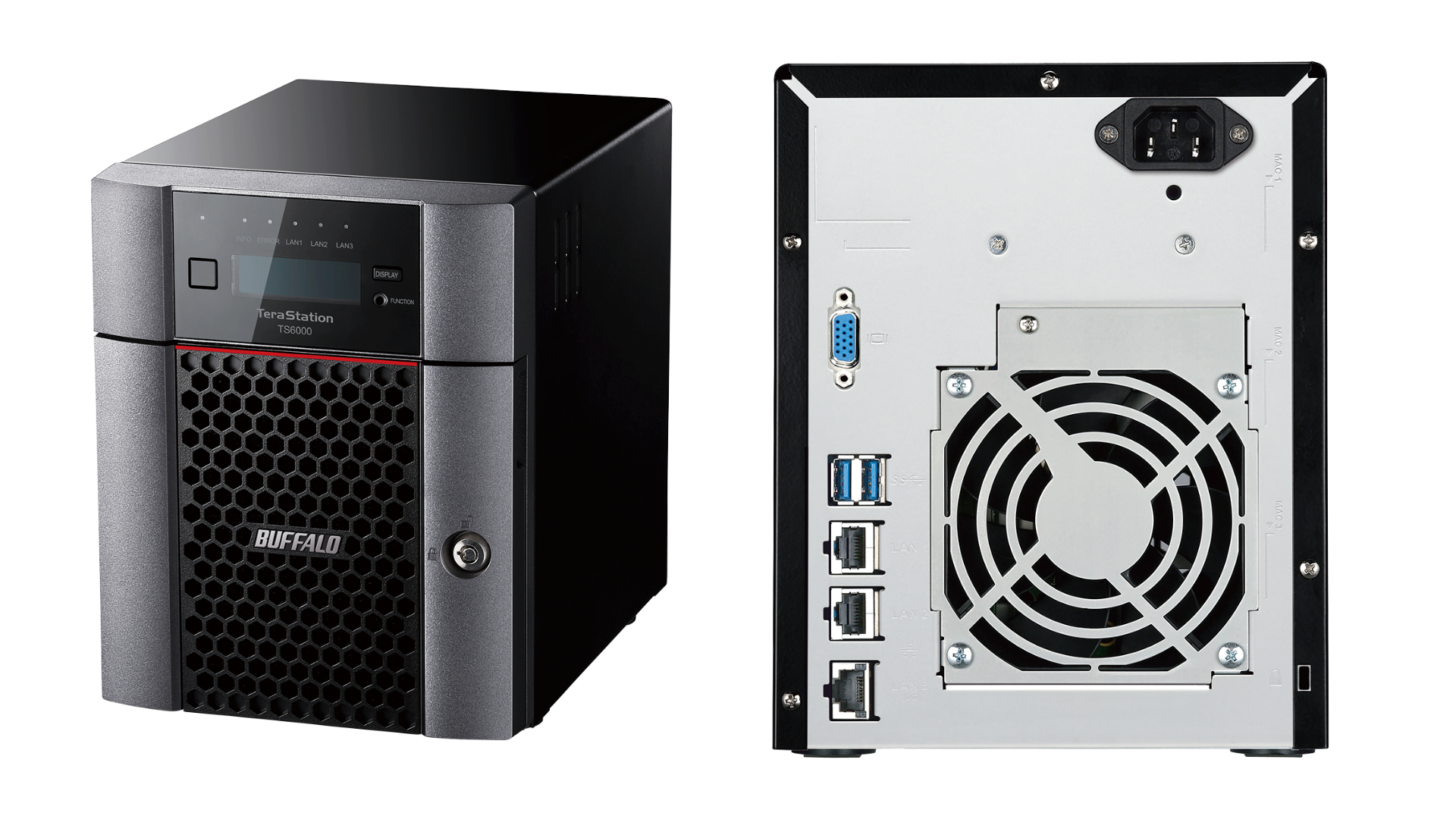NAS vs the cloud
Should you store your data locally or in the cloud?


When it comes to storing and sharing your important data, which approach will best fulfill your business or personal needs?
NAS box or Dropbox? My Cloud or OneDrive? Local or Cloud? There’s a fight on between the big online storage services and the hardware manufacturers, with both camps claiming the high ground on convenience, ease-of-use and cost. Both approaches have their strengths, but if you’re looking to safeguard your most important data or to share it, which way should you jump?
Performance
There's just no getting around it - NAS drives have a definite advantage when it comes to speed. With a NAS, read and write speeds are mainly affected by the bandwidth of the connection between your PC and the NAS, the size and number of the files, the power of the NAS's CPU and the quantity of RAM and the performance of the drives installed.
With online services, however, you're still constrained by the performance of the servers and the client-side hardware and software, but even more limited by your internet connection.
With a NAS, you may have a Gigabit Ethernet connection linking your PC and the unit, and even 802.11n Wi-Fi will give you up to 300Mbits/sec of bandwidth, rising up to between 400Mbits/sec and 1,300Mbits/sec if you use 802.11ac. The very fastest fibre-to-the-premises broadband packages top out at 300Mbits/sec, but the majority of us on fibre-to-the-cabinet packages are stuck at 100Mbits/sec, 70Mbits/sec or less.
What's worse, these are download figures, and fibre broadband remains an asynchronous technology. Your upload speeds for copying files may be up to 30Mbits/sec dropping to 7Mbits/sec and much lower. And let's not forget that many people are stuck on non-fibre connections, bringing speeds down still further.
Then there's the other side of the connection; the cloud service providers have only so much bandwidth to share out across connections. Is it practical for them to support even 100Mbits/sec uploads and downloads? (Hint: probably not.)
ChannelPro Newsletter
Stay up to date with the latest Channel industry news and analysis with our twice-weekly newsletter
The picture's pretty clear from the graphs, where we show upstream and downstream transfer rates for a subset of the large video files and high number of small files used to test this month's NAS drives (the connection made using the full set is impractical). The tests were conducted on a 38Mbits/sec fibre broadband connection with a 10Mbits/sec upload speed, so your mileage will vary, but unless you're on fibre-to-the-premises, a NAS will be noticeably faster than any cloud storage service.
We're talking around five seconds to transfer a file that will take around seven minutes to upload and three to six minutes to download from cloud storage. That's a significant difference.
Is this a significant issue? It depends. Cloud storage services are designed to work quietly in the background, and small files like, say, office documents, MP3 files or digital photos generally sync fast enough for most practical purposes.
If, however, you're uploading and downloading large video and other media files – or smaller files in bulk – then cloud storage might not be the way to go for you.
Price and capacity
NAS drives and the cloud operate very differently in terms of pricing and how you pay for the storage you need. If you opt for a NAS, you'll be paying the whole cost up front - but you won't be tied down to monthly or yearly fees.
NAS pricing naturally scales with the amount of storage the drive provides – but you can get your hands on excellent value options such as the WD My Cloud Mirror at around £300 for 6TB (equating to around £50 per terabyte). If you're after more power along with the ability to add your own drives, you'll be looking at around £450 for a typical setup.
Alternatively, cloud storage requires far less to be paid up front; instead, you'll be required to pay for the service over a number of years in order to continue using the service. For example, Google One's 2TB plan costs $9.99 per month (approximately £8.50 after tax) and works out at around £102 per year – meaning just a few years' worth of use could equate to a higher cost than a typical NAS drive.
By contrast, utilising the aforementioned 6TB My Cloud Mirror NAS over three years works out at a cost of approximately £17 per terabyte per year (without including the cost of the extra electricity used).
There is now a plethora of big cloud storage services out there to choose from, with each offering several plans to meet different storage capacity needs. Cloud firms such as Microsoft's OneDrive, Google One, Dropbox and Box all provide subscriptions ranging from affordable personal storage ($1.99 per month for 100GB with Google One, for example) to large business plans for enterprise users that store large amounts of data.
However, if you're looking to store a large amount of media and files, NAS drives and local storage prove to be better value if you're happy to pay the cost up front.
Accessibility and synchronisation
Some NAS manufacturers think remote access through a browser is enough to constitute a cloud storage feature, but what most users really have in mind is a combination of anywhere, anytime accessibility and the ability to synchronise files across multiple PCs and devices.
The big names in NAS have finally got their heads around this. They aren't quite matching Dropbox, Google Drive and OneDrive for the functionality of their browser-based portals, where we now take slick photo galleries, media streaming, document viewing and even editing features for granted, but they're getting closer.
Mobile app support is improving too, with effective file-browsing and downloading plus, in some cases, video-streaming capabilities.
Many of us now lean on Dropbox or OneDrive for automatic uploads of our smartphone's photos when we get back from a business trip or family day out. You might be surprised to know that many of the NAS-companion mobile apps now handle this as well.
Sync, meanwhile, is also on the up. When we looked at NAS drives a few years ago the cloud sync features were a little slow, primitive and often hard to set up, but now the best NAS units are taking care of setup automatically during installation, then working with well designed, Dropbox-like apps that take the pain out of the process. You can save a file to a local folder and be sure that it will replicate on your NAS, and from there to any other PCs that you sync. You can also be sure that the file will be accessible through a browser or through the manufacturer's mobile apps.
While the professional cloud services – Dropbox is still our top choice – will always win for synchronisation and accessibility, the NAS suppliers are catching up. Western Digital, Seagate and Netgear are the leaders in this group test, but Qnap and Synology aren't far behind.
Working in tandem
Of course, NAS and cloud services aren't outright rivals – they can actually work together. Many of the devices on test have features to either back up or sync files and folders with leading cloud services, including Dropbox, OneDrive and Google
Drive, and in some cases extending to Amazon S3 buckets, HiDrive or ElephantDrive.
You can use this as a second line of defence for storing vital or irreplaceable files off-site - a NAS drive is no protection against fire, flood or theft – or as a means of ensuring that your most important files are accessible even should your power fail or your internet connection be disrupted. Use NAS and cloud storage in this way and you can get the best of both worlds: the performance, one-off costs and capacity of NAS, with the streamlined, always-there accessibility of cloud.
Dan is a freelance writer and regular contributor to ChannelPro, covering the latest news stories across the IT, technology, and channel landscapes. Topics regularly cover cloud technologies, cyber security, software and operating system guides, and the latest mergers and acquisitions.
A journalism graduate from Leeds Beckett University, he combines a passion for the written word with a keen interest in the latest technology and its influence in an increasingly connected world.
He started writing for ChannelPro back in 2016, focusing on a mixture of news and technology guides, before becoming a regular contributor to ITPro. Elsewhere, he has previously written news and features across a range of other topics, including sport, music, and general news.

